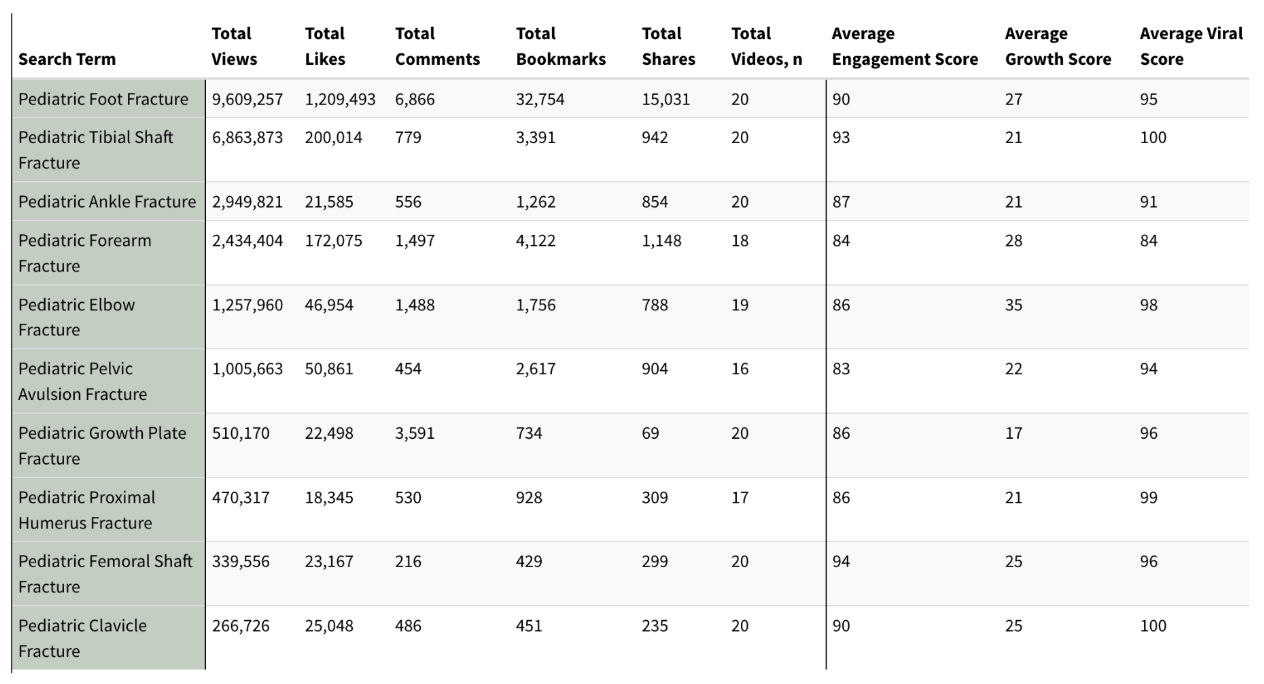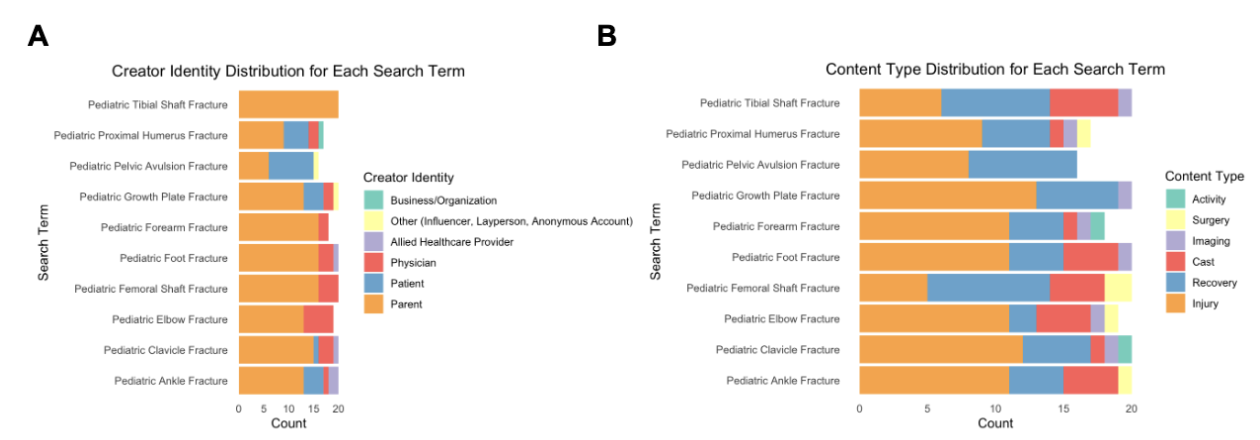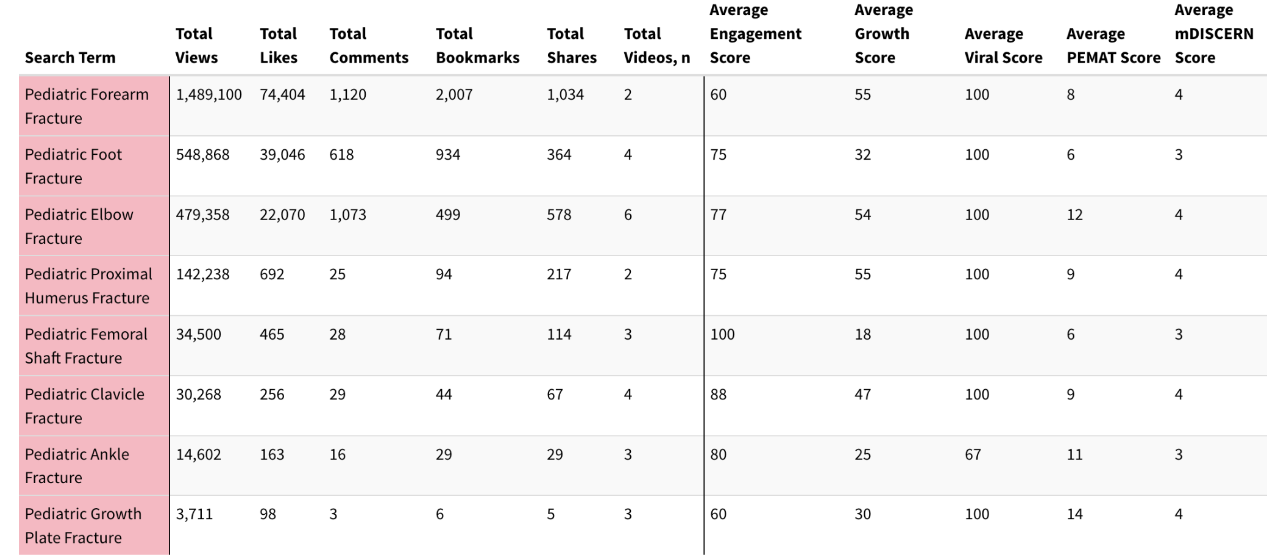Technology 4
Session: Technology 4
297 - An Analysis of TikTok’s Top Pediatric Fractures Content
Monday, April 28, 2025
7:00am - 9:15am HST
Publication Number: 297.3908
Camila Vicioso, Icahn School of Medicine at Mount Sinai, NY, NY, United States; Charu Jain, Icahn School of Medicine at Mount Sinai, New York, NY, United States; Uma Balachandran, Icahn School of Medicine at Mount Sinai, New york, NY, United States; Ryan G. Smolarsky, Icahn School of Medicine at Mount Sinai, New York, NY, United States; Laurel E. Wong, Icahn School of Medicine at Mount Sinai, New Yok, NY, United States; Luca M. Valdivia, Icahn School of Medicine at Mount Sinai, New York, NY, United States; Julian Javier, Icahn School of Medicine at Mount Sinai, New York, NY, United States; James Hong, Icahn School of Medicine at Mount Sinai, New York, NY, United States; Auston R.. Locke, Icahn School of Medicine at Mount Sinai, New York, NY, United States; Sheena Ranade, Icahn School of Medicine at Mount Sinai, New York, NY, United States
.jpg)
Camila Vicioso, BA (she/her/hers)
Medical Student
Icahn School of Medicine at Mount Sinai
NY, New York, United States
Presenting Author(s)
Background: Social media platforms offer healthcare providers (HCPs) effective ways to reach wide audiences. TikTok, a video-sharing platform with over 1 billion users, ranks highly in user engagement. Prior studies have examined TikTok content in healthcare specialties, though pediatric orthopedic injuries have not been explored. As social media usage grows, we aimed to analyze the metrics, engagement, content type, and creators of pediatric fracture-related TikTok videos.
Objective: To analyze the quality and engagement metrics of videos about pediatric fractures on TikTok to inform how pediatricians might use social media to educate the public on common injuries.
Design/Methods: Using the Pediatric Orthopedic Society of North America’s OrthoKids “I broke my” list, we compiled 10 common pediatric fracture terms. Each term was queried on a new TikTok account to capture unbiased results. We filtered the top 20 relevant videos per term, excluding those off-topic, non-English, or private accounts. We assessed video creator identity, content type, popularity metrics (likes, comments, views, bookmarks, shares), and engagement rates via the TikTok Score Calculator. For educational content, we rated understandability and actionability using the Patient Education Materials Assessment Tool (PEMAT) and video quality using mDISCERN scores. Data were analyzed on R.
Results: In total, 190 videos were included, reaching 25.7M views, 1.79M likes, and 16.4K comments (Fig. 1). Most videos were from parents or patients discussing injury and recovery (Fig. 2). Among educational videos, 89% were from HCPs, and all HCP videos (n=27) were classified as educational. These videos received 2.7M views and are detailed by search term in Fig. 3. HCP videos had an average mDISCERN score of 3.54/5, indicating good quality, and an average PEMAT score of 9.52/15, showing high understandability/actionability. Engagement scores were high overall, with growth scores significantly higher for HCP videos (mean: 39.5/100, range: 25-55) compared to all videos (mean: 24.2/100, range: 17-35). Viral scores were high across all terms, indicating strong viewer interest.
Conclusion(s): This study highlights TikTok's potential for pediatricians as an educational platform. Understanding which video types engage viewers and identifying traits of effective HCP content can help pediatricians create impactful videos to raise awareness about pediatric injuries. This approach may aid in injury prevention and enhance caregiver confidence in managing fractures. High view counts reveal strong caregiver interest in both sharing and learning about pediatric injuries.
Figure 1. Summary of TikTok Engagement Metrics for Popular Pediatric Fracture Videos
 Figure 1. In total, 190 videos were included, reaching 25.7M views, 1.79M likes, and 16.4K comments. Videos about pediatric injuries to the lower extremity were the most popular. All videos on average had high engagement and viral scores.
Figure 1. In total, 190 videos were included, reaching 25.7M views, 1.79M likes, and 16.4K comments. Videos about pediatric injuries to the lower extremity were the most popular. All videos on average had high engagement and viral scores.Figure 2. Summary of Creator Identity and Content Type for Each Search Term
 Figure 2. (A) Most videos were created by parents and patients, with physicians and healthcare providers totaling 27 (14.2%) of videos. (B) Most videos were about injury, recovery, and casts.
Figure 2. (A) Most videos were created by parents and patients, with physicians and healthcare providers totaling 27 (14.2%) of videos. (B) Most videos were about injury, recovery, and casts.Figure 3. Summary of TikTok Engagement Metrics for Healthcare Provider (HCP) Videos
 Figure 3. 100% of HCP videos were classified as educational and had high understandability and actionability (PEMAT score), as well as high video quality (mDISCERN score). These videos totaled 2.7M views and 137K likes.
Figure 3. 100% of HCP videos were classified as educational and had high understandability and actionability (PEMAT score), as well as high video quality (mDISCERN score). These videos totaled 2.7M views and 137K likes.
